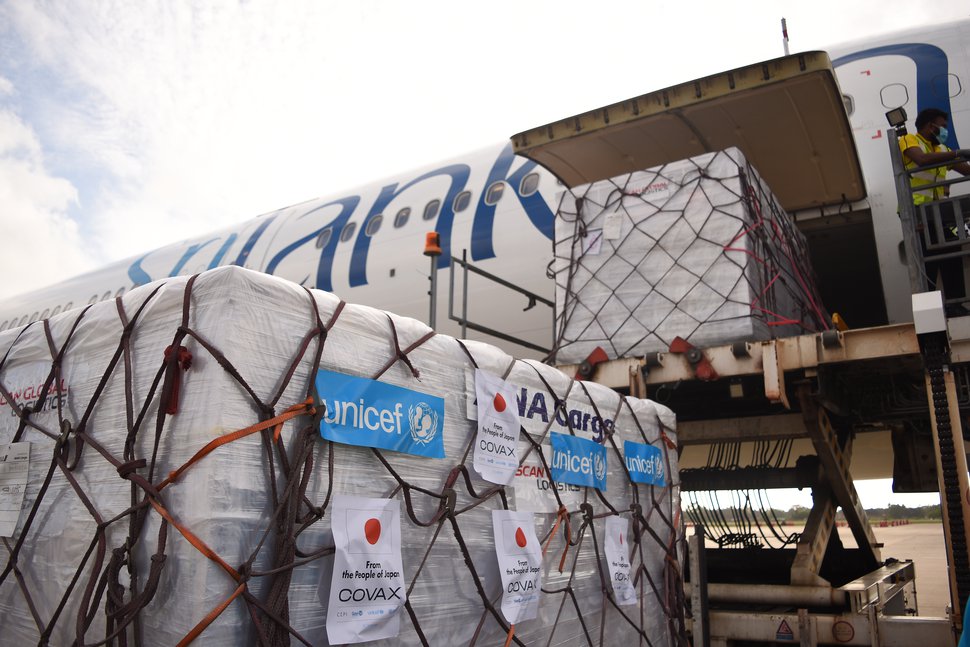Unsolved dispute over counting COVID vaccine donations as aid leaves loopholes
At the eleventh hour, donors were unable to agree on a common set of rules for reporting COVID vaccine donations as official development assistance (ODA). The original deadline of early November was long passed, and something had to be in place in time for donor ODA reporting for 2021, which is due in April.
The Chair of the OECD Development Assistance Committee (DAC) put out a statement last week, repeating a previous recommendation that donors report donated “excess vaccines doses” at a price of 6.72 dollars per dose. The statement notes that the matter is complicated by the fact that high-income countries have paid very different prices for their COVID-19 vaccines and that DAC members did not agree on a single price for donated doses.
Photo: UNICEF Sri Lanka
The 6.72 figure represents the average price for vaccines donated to COVAX, the multilateral mechanism providing developing countries with vaccines. The OECD says this price level is meant to ensure “consistency, transparency and comparability” in reported ODA.
According to the UNICEF COVID-19 Vaccine Market Dashboard, high-income countries donated almost 1 billion doses to developing countries in 2021, half of them through COVAX. If donors report all these doses as aid at a rate of 6.72 dollars per dose, it will amount to about USD 6 billion.
According to the statement, donors “have the right” to report less than 6.72 dollars if they paid less. But it adds a caveat: “If a member decides not to report in line with the OECD guidance, that member must include detailed information on the price it has paid as well as the vaccine names and the number of doses. If confidentiality constraints prevent the member from indicating the price, the guidance recommends applying the price of USD 6.72 per dose instead or abstaining from reporting the donations in ODA.”
In other words, a country that donates vaccines for which it paid 10 dollars or 20 dollars per dose can report these doses as aid at higher rates as long as it is open about the original price.
Euan Ritchie, economist at the Center for Global Development in London, has been following the donors’ negotiations closely. Asked to unpack the OECD’s caveat, he says: “it reads like nothing more than an acknowledgement that they have no way of enforcing consistency. In principle, it means a complete free-for-all, with donors valuing donated vaccines at whatever price they like.”
In practice, Ritchie says, donors who bought vaccines at above USD 6.72 will probably value doses at the price they bought them, but those who bought at a lower price will use the DAC recommendation. This risks USD 6.72 becoming a floor, rather than a ceiling, for reporting ODA, he says.
Ritchie has earlier argued that donated vaccines should not count as ODA at all.
Indeed, when discussions in the DAC about the aid eligibility of donated COVID vaccines began last year, many donors argued along similar lines. An OECD report from a June meeting states that the “dominant view” then was that such donations should not be reported as aid, for the following reasons:
- The original intent of buying the doses had nothing to do with helping developing countries. By signing so many contracts, donors actually contributed to the lack of doses available to other countries.
- The donation of excess vaccine doses, if counted in ODA, could replace much-needed ODA for things like health systems.
- Allowing donors to score ODA for their donation of vaccine in excess could create perverse incentives. This could also legitimise hoarding strategies that led to the current inequitable access situation.
Development Today has earlier reported that Norway, Canada, and the United Kingdom were satisfied with the DAC’s proposed rate of 6.72 dollars per donated dose, while Sweden wanted differentiated prices. DEVEX has reported that the United States and the Netherlands remained opposed to counting vaccine donations as aid.
Tommy Löfgren at the Swedish Foreign Ministry says that although Sweden had earlier thought that differentiated prices would be a good option, it was more important to reach a compromise. Commenting on the caveat, he says: “It reflects pragmatism at this late stage. My impression is that most countries will report in line with the guidance. We hope the directives will be decided earlier on than this in the next round … All of us involved are concerned about the integrity of ODA and not inflating ODA levels.”
Civil society organisations continue to oppose the whole reporting exercise. “Excess doses originally bought by rich countries at the direct cost of saving lives in poorer countries should never be counted as aid, let alone at the eyewatering prices paid because of vaccine monopolies rich countries have refused to challenge,” says Anna Marriot, Oxfam’s Health Policy Manager to Development Today. “This guidance leaves the door wide open to a massive diversion of urgently needed aid for these countries at a time of unprecedented crisis.”
The European Network on Debt and Development issued a statement on behalf of 35 organisations worldwide condemning the donors’ willingness to spend aid on vaccine donations. Nerea Craviotto, Senior Policy and Advocacy Officer at the European Network on Debt and Development, says to Development Today: “It is unclear how safeguards foreseen in the reference guidelines would apply to donors that decide to report a different price than the recommended USD 6.72. At the end of the day, DAC members should have simply dropped their plans to report excess vaccine donations in their aid statistics.”
Meanwhile, the Director of the Africa Centres for Disease Control John Nkengasong has said to Politico this week that high-income countries (HICs) should pause their COVID-19 vaccine donations to avoid a glut of deliveries that recipient countries do not have the capacity to absorb and risk expiring before they can be used. In addition to doses already shipped, 1.2 billion doses pledged to COVAX by HICs are not yet delivered.

